How To Turn A Raspberry Pi Zero W Into A Thermal Imaging Camera
Build a thermal photographic camera with Raspberry Pi and Get
Create a unproblematic thermal camera with a depression-cost sensor and Raspberry Pi 4 using Go
The spread of the COVID-nineteen virus has gripped many parts of the world (especially in Asia) in the past couple of months and has affected many aspects of a lot of people'due south lives, including mine. I no longer commute to piece of work every day and try to work from dwelling as much every bit possible. Non-essential meetings are cancelled (which is a good thing) and other meetings are more often than not done through video or audio conferencing. Nearly larger-scale events like conferences have been postponed to avoid gathering of people, which increases the take chances of COVID-nineteen spreading.
For business organization continuity, my team has been segregated to Team A and Squad B, they have turns to use the office on alternating weeks, and neither the twain shall run into. Also, when entering nearly every function building, anybody's body temperature is checked and if they have fever, they are not immune in and instead advised to see a dr..
In a management meeting recently, we were discussing about how to deal with the flow of people (both employees and visitors) into our various offices around the island. Checking temperature is mostly washed through not-contact thermometers past security guards. This even so is a laborious and fourth dimension-consuming method, and equally people caput to their offices this comes a bottleneck that ironically causes people to gather.

One of the suggestions was to use thermal imagers to exercise mass screening, which was speedily agreed. Still, only the offices with more people menstruum will be equipped with them since they're not cheap. Per set they can meet tens of thousands of dollars! One of my colleagues joked and said he'd like to have one for his personal office to screen anybody who comes by.
That, of course, set me off immediately.
Raspberry Pi to the rescue
I wrote a story last December on how I used my iPad Pro equally a development device by attaching a Raspberry Pi4 to it as a USB gadget. That was just the start, of course. The Pi4 is much more than a small-scale reckoner. It will now as well be the base of my new thermal screener.
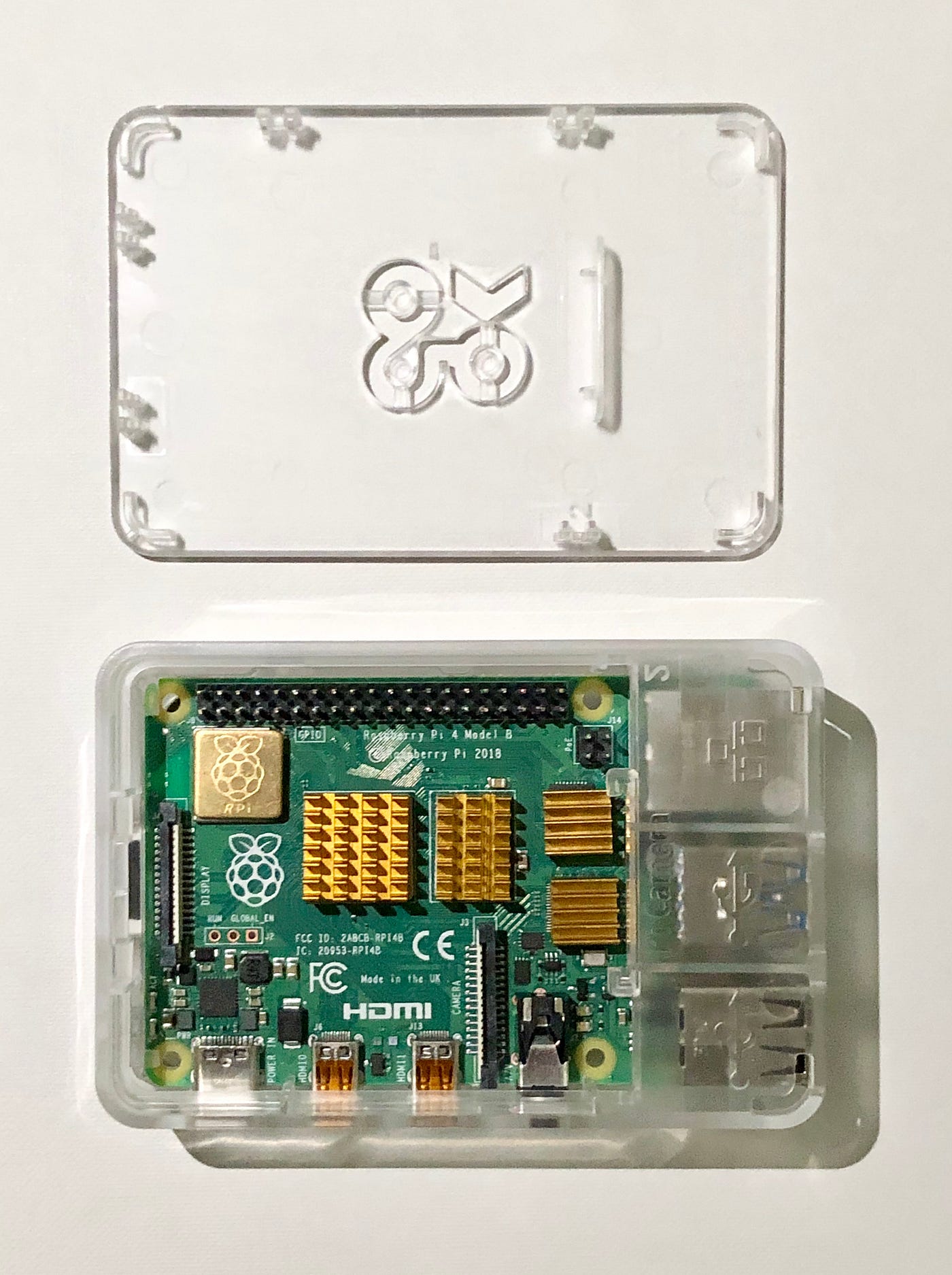
For this projection I volition be using Go primarily and information technology will be compiled and run on the Pi4. Information technology will:
- Read data from the AMG8833 thermal camera sensor.
- Convert the information to temperature readings.
- Generate thermal images based on the readings.
To display the readings, the software volition also act as a web server and continually display the images on a web page. Likewise considering the Pi4 is run headless, the thermal camera software volition be started and run as a systemd service.
This is how it should turn out if all is well. This is a screenshot of me sitting down on a sofa effectually 1 meter abroad from the photographic camera and raising my right hand.
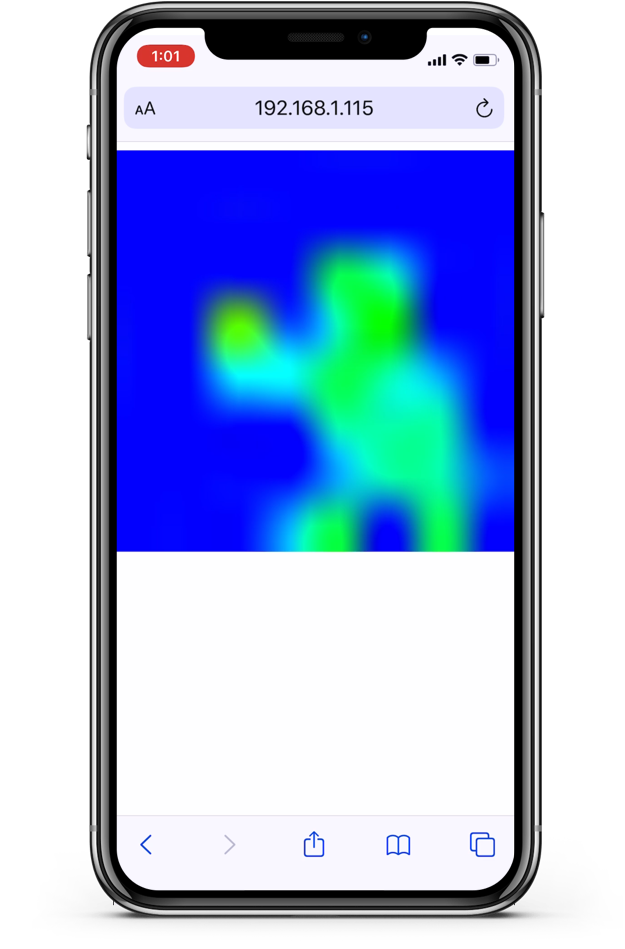
The thermal camera hardware
The idea is to build a really cheap thermal camera for temperature screening. For the hardware I'one thousand simply re-using my existing Pi4 and connecting it to a AMG8833 thermal photographic camera sensor.
The AMG8833 is i of the cheapest thermal photographic camera sensors effectually (slightly more than $60 Singapore dollars, or US$39.95). The sensor itself is a 8x8 assortment of infra-red sensors from Panasonic that return an array of 64 individual infrared temperature readings over I2C. Information technology measure temperatures ranging from 0°C to eighty°C with an accuracy of +- ii.5°C and tin can discover a human from a distance of upwards to vii meters (detection means information technology can sense the oestrus differences). It can generate upwardly to 10 frames per second (or as frame every 100 millisecond).

The pin out connections from the AMG8833 are quite straightforward. I'll be using but 4 out of the six pins.
- Vin – this is the power pin. The sensor uses 3.3V so I connect it to corresponding 3.3V pin (pin one) on Pi4
- 3Vo – this is the 3.3V output, I won't be using information technology.
- GND – this is mutual ground for power and logic. I connect it to ground pin (pin 9) on the Pi4. There are more than 1 ground pin on the Pi4, you can use whatever of them.
- SCL – this is the I2C clock pivot and nosotros connect information technology to the corresponding SCL pin on the Pi4 (pin 5).
- SDA – this is the I2C data pin, and we connect information technology to the respective SDA pin on the Pi4 (pivot 3).
- INT – this is the interrupt-output pin. It is 3V logic and is used to detect when something moves or changes in the sensor vision path. I'm non using it.
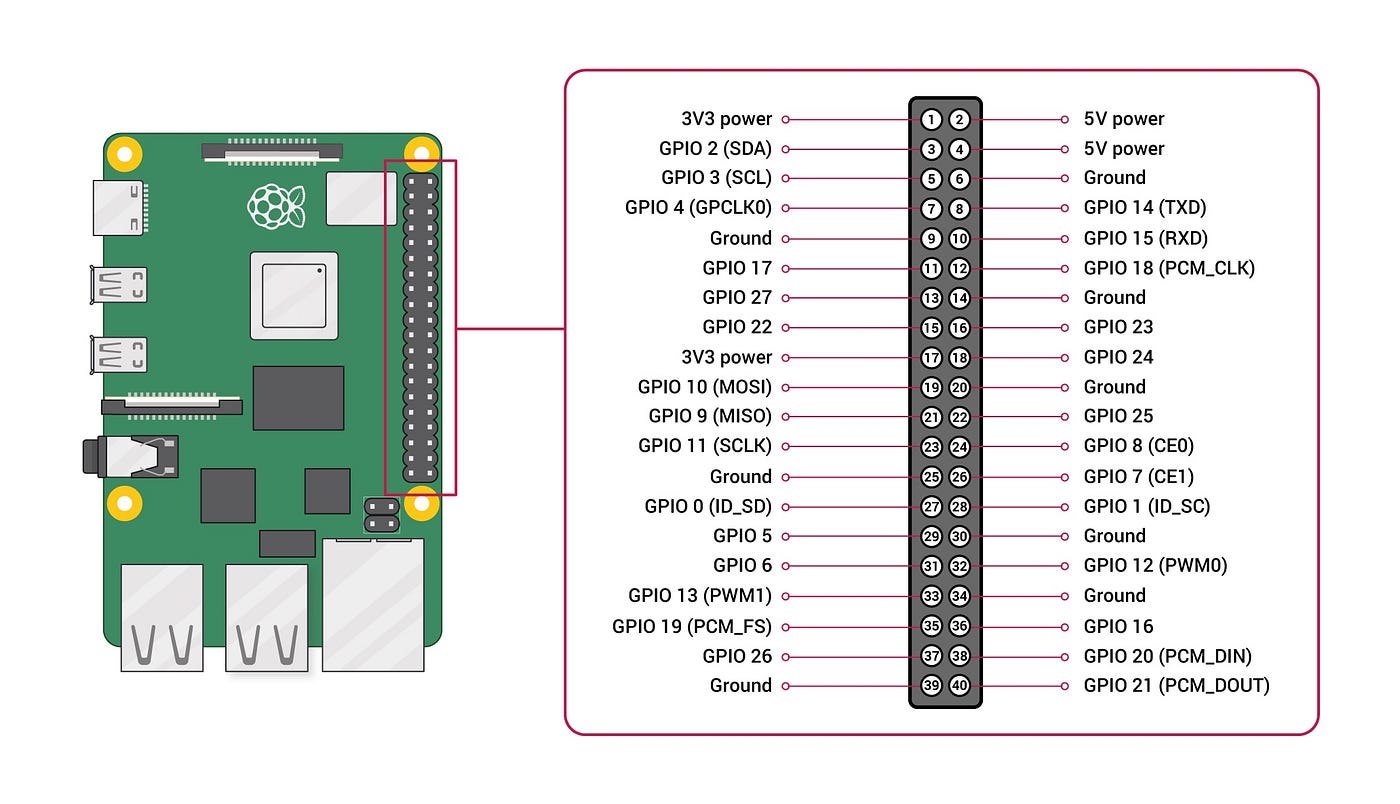
This is how it looks like after connecting the pins.
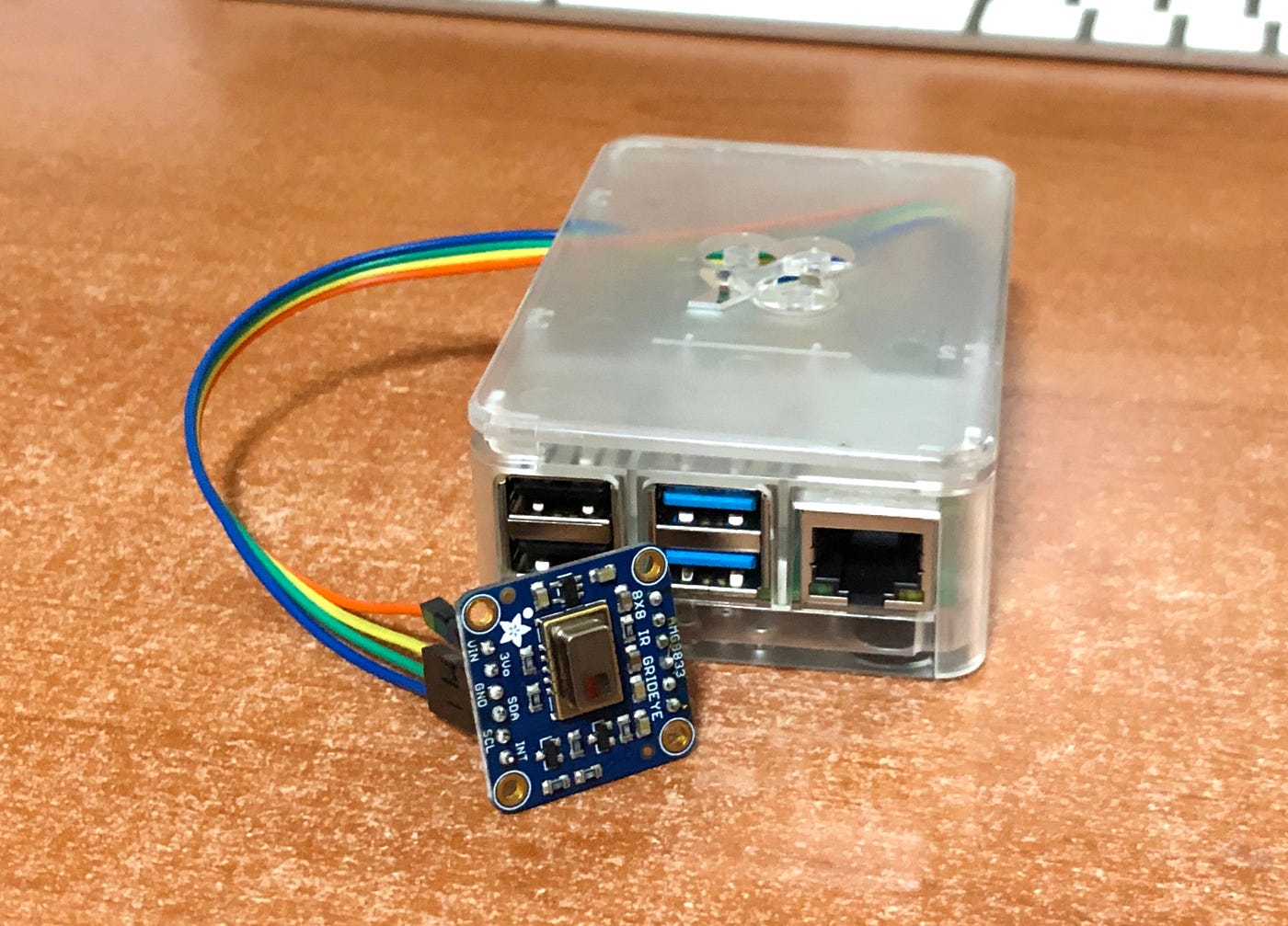
To stand the thermal camera, I took some discarded foam bundle cushion and carved a scaffolding mini-belfry to concur it.
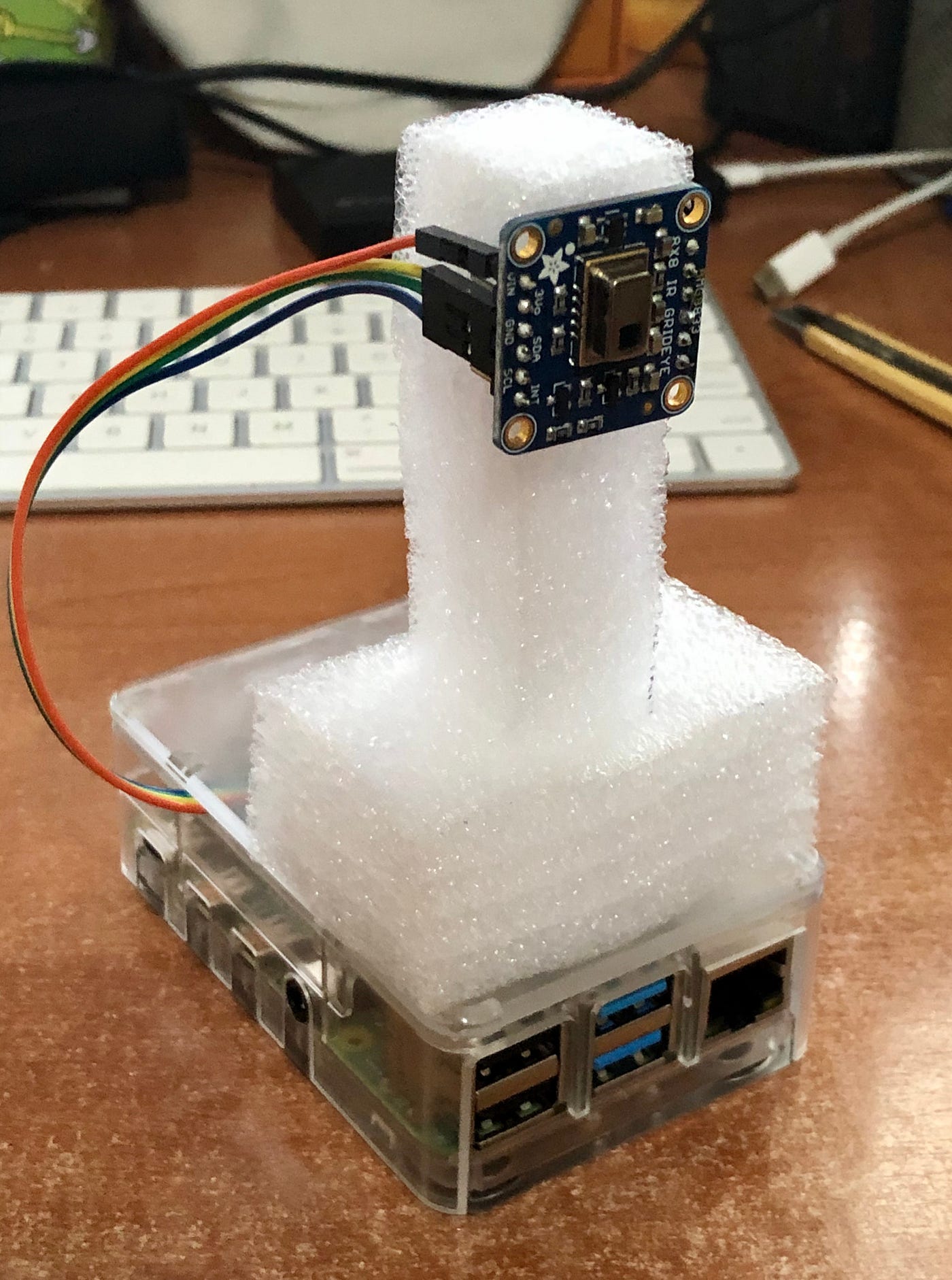
And we're done! It looks kind of scrappy but it'll do.
The thermal camera software
Let's come across how the software works side by side.
For this project I used 2 external libraries. The first is the amg8833 project, which I took from https://github.com/jweissig/amg8833. The project itself is a port of Adafruit's AMG88xx Library. The second library is a pure Golang image resize library https://github.com/nfnt/resize. The rest are all from the Become standard libraries.
Variables and parameters
We start off with the variables used as well as list of parameters that we capture from the command-line.
Let's look at the variables. amg is the interface to the sensor using the amg8833 library. I applyframe to store the resized prototype captured from the sensor, which is then used by the web server to serve out to the web page. frame is a base64 encoded string.
The colors piece is a list of all the colors used in the image. This variable is declared here merely populated in the heatmap.become file. grid is an array of 64 floating point temperature readings that is read from the AMG8833 8x8 sensor.
I capture a few parameters from the user when I start the software from the command line. refresh is the refresh rate to capture and brandish the images. Past default information technology'due south 100 milliseconds. minTemp and maxTemp are the minimum and maximum temperature ranges we can desire to show on the paradigm. newSize is the width of the final prototype that's shown on the browser.
Finally, the mock parameter is used to decide if we are really capturing from the sensor or using mock information. I used this when I was developing the software because information technology was easier to examination.
Main
I first past checking if the user wants to use the mock data or the actual data captured from the sensor. If the user wants to capture from the sensor, I initialize the amg and and then start a goroutine on startThermalCam.
The startThermalCam office is simple, information technology just grabs the temperature readings into the grid and then wait for a catamenia of time equally divers in refresh.
The rest of the primary office is merely setting up the web server. I just accept 2 handlers for the web server. The first is for the web page, and the second returns the image captured from the thermal camera.
Web
The first handler, alphabetize uses the public/alphabetize.html template, passing it the refresh value. It likewise triggers a goroutine that start generating frames into the frame variable.
The getFrame handler takes this frame (which is a base64 encoded string) and pushes it out to the browser.
The generateFrames function continually generates the paradigm and places it into the frame variable. This image is encoded as a PNG file and then further encoded as a base64 string to exist displayed as a data URL.
Create images
The createImage is where the chief activeness is. Call back the sensor captures data every bit an array of 64 temperature readings in the filigree variable. Creating an image from this is simple.
First, I use the image standard library to create a new RGBA image. And then, for each temperature reading, I find get the index of the corresponding color I wanted and use that to get the hex color integer from the colors array.
With that, I grab the red, green and blue values from the integer and set up it into consecutive elements of the Pix attribute of the image. If you remember from the A gentle introduction to genetic algorithms story I wrote earlier, Pix is a byte array with 4 bytes representing a pixel (R, G, B and A each represented by a byte), The red, green and blue bytes fit nicely into them and by the time the loop ends, nosotros have a 8 pixel past eight pixel thermal prototype!
Of class, this is mode likewise small to show on the screen, so we employ the resize library to resize the image to a more respectable size. Notice that it's not just making the pixels larger, we utilise an algorithm (specifically the Lanczos resampling algorithm) to create a much smoother image when enlarged.
Displaying on the browser
The final flake is to display it on the browser. Here's the HTML template that displays the prototype.
If you lot're not familiar with Go, the { . } is just the value that is replaced in the final HTML that is displayed by the browser. In this instance, it'south the value (in milliseconds) of how often the prototype should be refreshed.
That'south it, the software function is washed!
Running the software
Let's take a look at running the software. Call up this is going to be run on the Pi4.
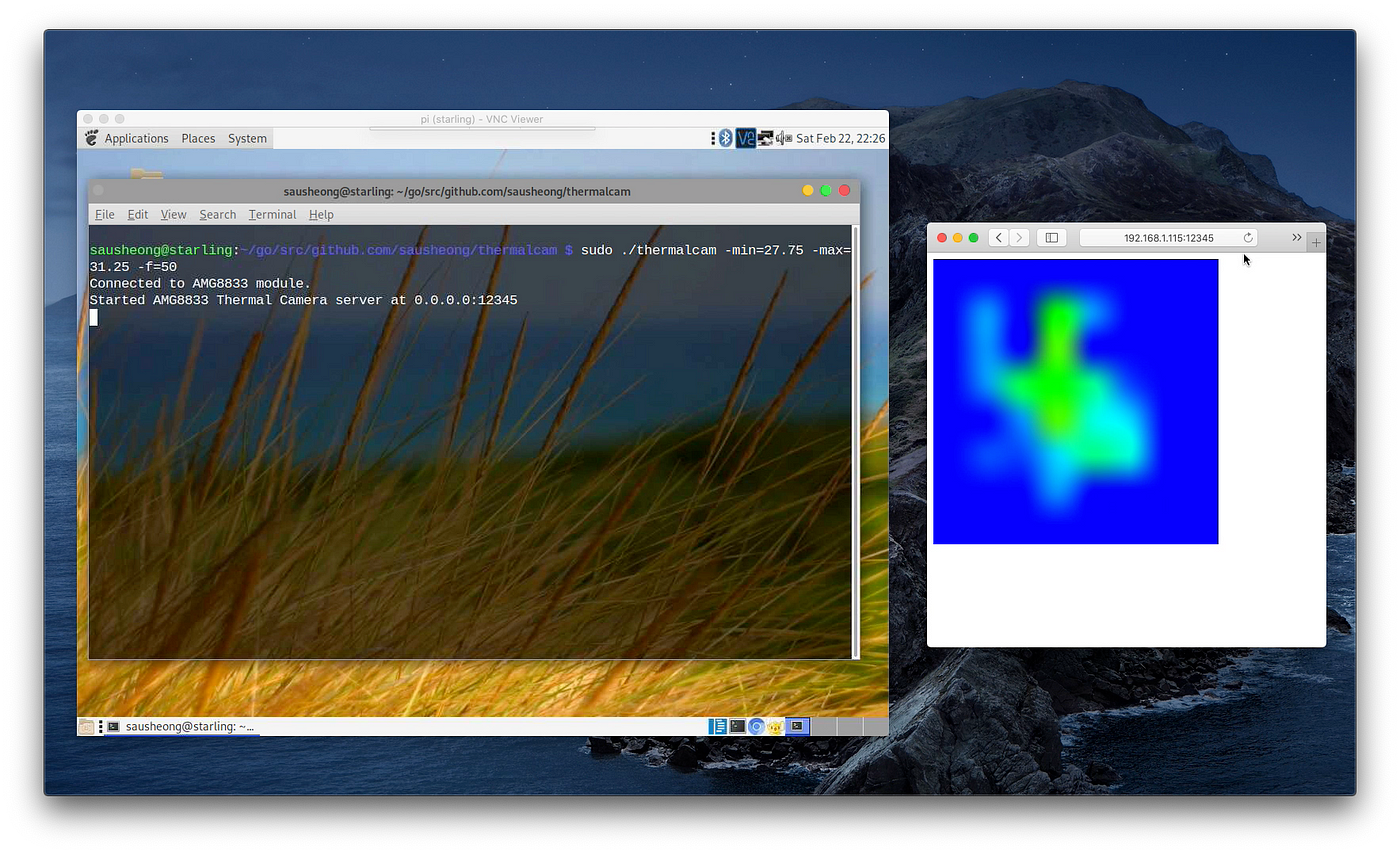
The larger window on this screenshot is VNC-ing into the Pi4 while the smaller browser on the side is running it on my MacBook Pro Safari browser. I was sitting down on a chair and raising my correct hand.
Making it a service
The software runs but we need to start it from the command-line. Every bit an IoT device this is not ok. It should start when the device is powered on and we shouldn't need to log into the device, start up the command line and type in the command to get-go it!
This means the thermal photographic camera software should be run as a service on startup. To do this, I'thousand going to make it into a systemd service. Here are the steps:
- Go to the directory
/lib/systemd/arrangement - Create a file named
thermalcam.servicewith the post-obit content (this is the unit file). Remember, you lot demand to take sudo rights to do this. The important role is theExecStartwhich specifies the command that will exist executed
[Unit of measurement]
Description=Thermal Camera [Service]
Type=unproblematic
ExecStart=/abode/sausheong/go/src/github.com/sausheong/thermalcam/thermalcam -min=27.75 -max=30.75 -f=50 -southward=480 [Install]
WantedBy=multi-user.target
3. Give the file the necessary permissions:
$ sudo chmod 644 /etc/systemd/system/thermalcam.service 4. Now y'all can start the service:
$ sudo systemctl start thermalcam 5. You can check the condition here:
$ sudo systemctl status thermalcam You should get something like this if it's working. You can start or cease the service using systemctl.

6. Finally to make sure the service starts whenever the Pi4 is powered on:
$ sudo systemctl enable thermalcam At present you lot can place the thermal camera anywhere and the software will start as before long as the Pi4 is powered on! Here it is the photographic camera in action on a shelf, adjacent to my Tv set. I used a bombardment pack to power the Pi4 but I can also pull a USB power adapter to practise the aforementioned.
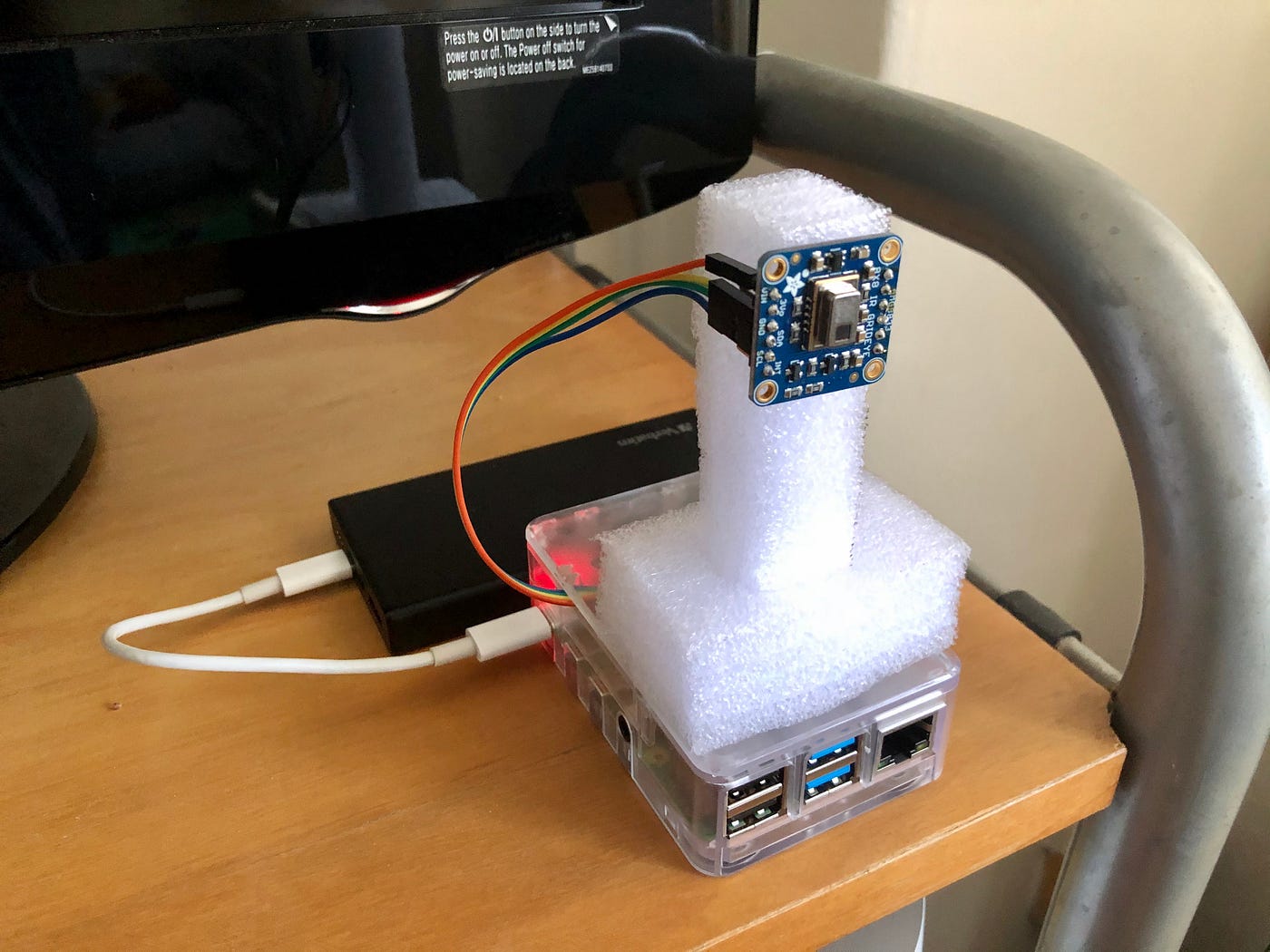
Let'due south see how this looks like on the iPhone Safari browser.
Farther thoughts
You might notice the motion picture quality is not that amazing. That's to exist expected, the sensor is later all only a 8x8 grid. With 64 data points, it's not and then easy to make out the details. At that place are definitely ameliorate thermal camera sensors out at that place. Here are some that I found from sniffing around:
- FLIR Lepton — https://www.flir.com/products/lepton/ (more than $100, so out of my price range)
- MLX90640—https://www.adafruit.com/production/4407 (it was out of stock when I was looking around)
I have a feeling that the MLX90640 will exist better, later on all it is a 32x24 pixel sensor, and with 768 information points, that's 12x more than the AMG8833. Unfortunately I couldn't get hold of one since it's out of stock everywhere I looked effectually.
The software tin detect people only it tin't really be used for thermal screening because it needs to be tuned to the correct temperature to screen. Unfortunately (or fortunately) I don't have any way of doing this.
So far I'm only using this for thermal imaging, you lot can think of other things you can practise with it, similar detecting people or detecting if certain equipment is besides hot and and then on.
Knock yourself out!
Source: https://levelup.gitconnected.com/build-a-thermal-camera-with-raspberry-pi-and-go-8f70451ad6a0
Posted by: everettthereatend.blogspot.com


0 Response to "How To Turn A Raspberry Pi Zero W Into A Thermal Imaging Camera"
Post a Comment